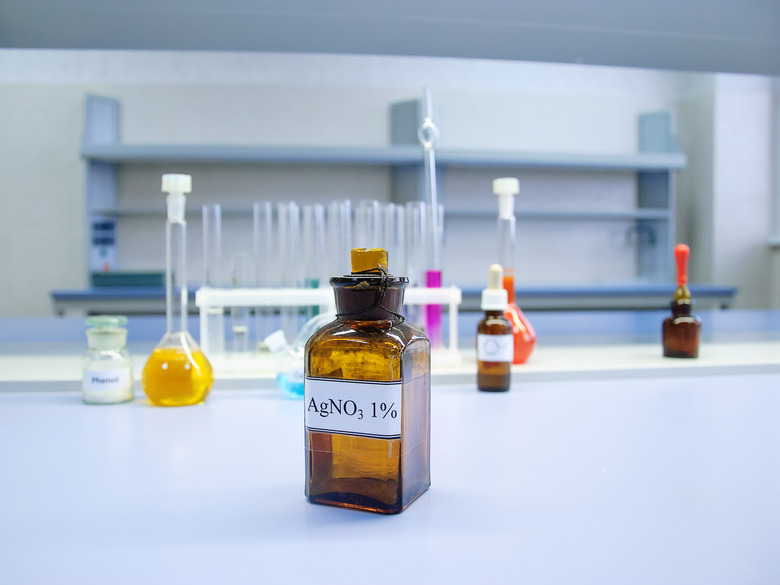How To Prepare Silver Oxide From Silver Nitrate
While silver is often most appreciated for its metallic luster, the element also plays an important role in several intriguing chemical reactions. This often unnoticed quality is made more obvious when silver nitrate is utilized to create silver oxide, during which silver and its compounds undergo changes in both state and color. Silver oxide, produced by the formula 2 AgNO3(aq) + 2 NaOH(aq) –> Ag2O(s) + 2 NaNO3(aq) + H2O(l), is also a useful chemical in and of itself. In various forms, it is used as a carbon scrubber, a battery component and even an antimicrobial agent.
Step 1
Place gloves on. Rinse the test tube in deionized water and place in the stand.
Step 2
Pipette 20 mL silver nitrate into the test tube. Rinse the pipette in deionized water, then pipette 20 mL sodium hydroxide into the test tube. You should see a brown precipitate form as the two chemicals mix.
Step 3
Let the reaction stand for 20 minutes, or until the precipitate has completely settled to the bottom of the test tube. The solid silver oxide will form a dull brown clump at the bottom of the tube. Tilt the tube to ensure that the precipitate has completely settled from solution.
Step 4
Slowly pour out the liquid sodium nitrate solution into the beaker to obtain a remaining clump of solid silver oxide. Dispose of the sodium nitrate in a sealed container as it is toxic, and possibly a source of carcinogens.
Step 5
Light your Bunsen burner with the sparker. Grip your test tube with tongs and hold it a few inches to the side of the flame to slowly drive off any remaining water vapor, leaving behind a dry silver oxide powder.
Things Needed
- Gloves
- Test tube
- Test tube stand
- Pipette
- 0.1 M silver nitrate (AgNO3)
- 0.5 M sodium hydroxide (NaOH)
- Deionized water
- Beaker
- Tongs
- Bunsen burner
- Sparker
TL;DR (Too Long; Didn't Read)
Be careful not to hold the test tube too close to the flame, as Ag2O decomposes at high temperatures.
Warning
Silver nitrate is highly toxic, and can cause burns or staining of the skin. Sodium hydroxide is also a possible irritant. Using these chemicals in low concentrations (low molarity) reduces most of this danger, but do not ingest any of the products or reactants.
Cite This Article
MLA
Tasi, Alec. "How To Prepare Silver Oxide From Silver Nitrate" sciencing.com, https://www.sciencing.com/prepare-silver-oxide-silver-nitrate-8768375/. 21 July 2011.
APA
Tasi, Alec. (2011, July 21). How To Prepare Silver Oxide From Silver Nitrate. sciencing.com. Retrieved from https://www.sciencing.com/prepare-silver-oxide-silver-nitrate-8768375/
Chicago
Tasi, Alec. How To Prepare Silver Oxide From Silver Nitrate last modified August 30, 2022. https://www.sciencing.com/prepare-silver-oxide-silver-nitrate-8768375/
